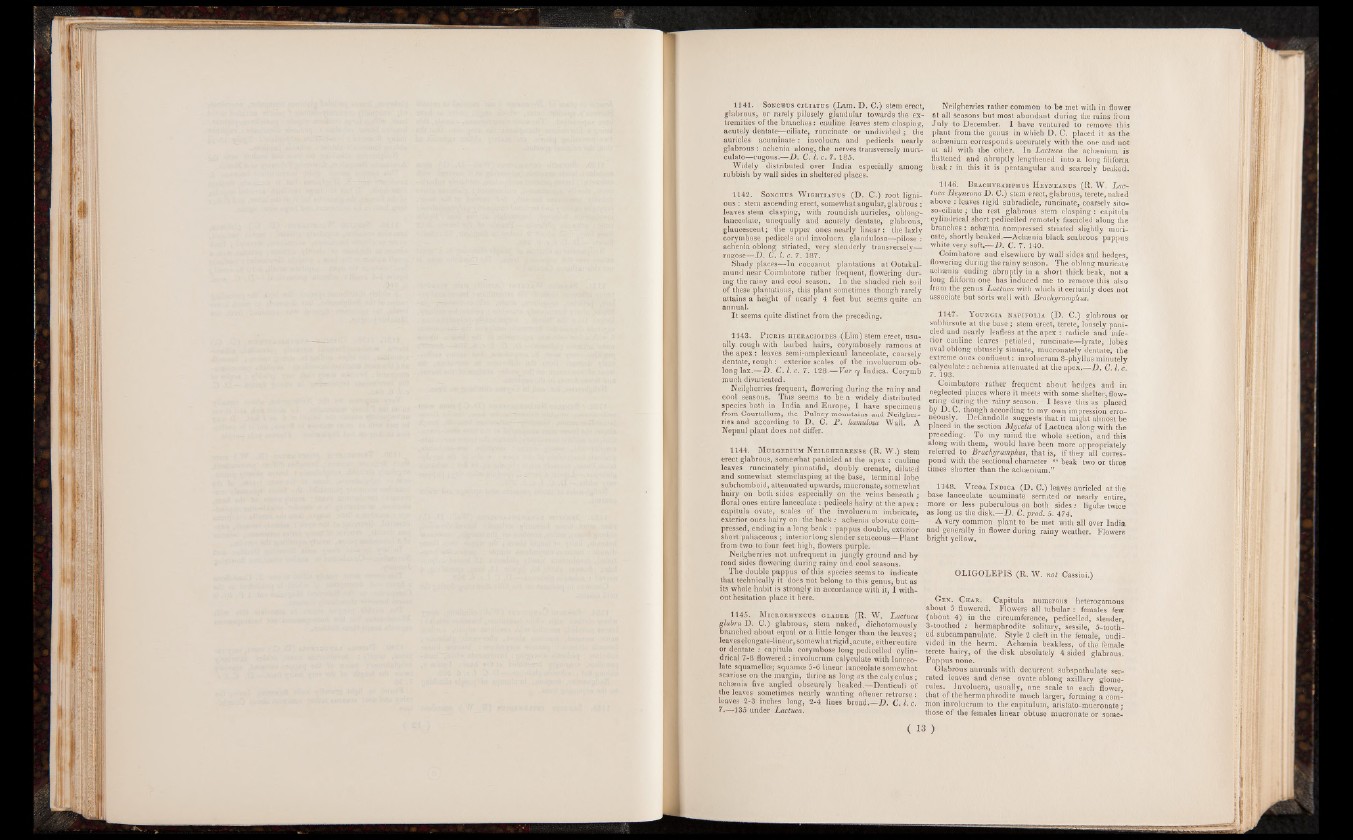
1141. Sonchus ciliatus (Lam. D. C.) stem erect,
glabrous, or rarely pilosely glandular towards the extremities
of the branches: cauline leaves stem clasping,
acutely dentate—ciliate, runcinate or undivided ; the
auricles acuminate: involucra and pedicels nearly
glabrous: achenia along, the nerves transversely muri-
culato—rugous.—D. C. 1. c. 7.185.
Widely distributed over India especially among
rubbish by wall sides in sheltered places.
1142. Sonchus Wightianus (D. G.) root ligni-
ous : stem ascending erect, somewhat angular, glabrous:
leaves stem clasping, with roundish auricles, oblong-
lanceolate, unequally and acutely dentate, glabrous,
glaucescent; the upper ones nearly linear: the laxly
corymbose pedicels and involucra glanduloso—pilose :
achenia oblong striated, very slenderly transversely—
rugose—D. C. 1. c. 7. 187.
Shady places—In cocoanut plantations at Ootakal-
mund near Coimbatore rather frequent, flowering during
the rainy and cool season. In the shaded rich soil
of these plantations, this plant sometimes though rarely
attains a height of nearly 4 feet but seems quite an
annual.
It seems quite distinct from the preceding.
1143. P icris hieracioides -(Lim) stem erect, usually
rough with barbed hairs, corymbosely ramous at
the apex : leaves semi-amplexicaul lanceolate, coarsely
dentate, rough: exterior scales of the involucrum oblong
lax.—D. C. 1. c. 7. 128.— Var <y Indica. Corymb
much divaricated.
Neilgherries frequent, flowering during the rainy and
cool seasons. This seems to be a widely distributed
species both in India and Europe, I have specimens
from Courtallum, the Pulney mountains and Neilgherries
and according to D. C. P . hamulosa Wall. A
Nepaul plant does not differ.
1144. Mulgedium Neilgherrense (R. W.) stem
erect glabrous, somewhat panicled at the apex : cauline
leaves runcinately pinnatifid, doubly crenate, dilated
and somewhat stemclasping at the base, terminal lobe
subrhomboid, attenuated upwards, mucronate, somewhat
hairy on both sides especially on the veins beneath ;
floral ones entire lanceolate : pedicels hairy at the apex:
capitula ovate^ scales of the involucrum imbricate,
exterior ones hairy on the back; achenia obovate compressed,
ending in a long beak : pappus double, exterior
short paliaceous; interior long slender setaceous—Plant
from two to four feet high, flowers purple.
Neilgherries not unfrequent in jungly ground and by
road sides flowering during rainy and cool seasons.
The double pappus of this species seems to indicate
that technically it does not belong to this genus, but as
its whole habit is strongly in accordance with it, I without
hesitation place it here.
1145. Microrhyncus glaber (R. W. Lactuca
glabra D. C.) glabrous, stem naked, dichotomously
branched about equal or a little longer than the leaves •
leaves elongate-linear, somewhat rigid, acute, either entire
or dentate ; capitula corymbose long pedicelled cylindrical
7-8 flowered : involucrum calyculate with lanceolate
squamelloe; squamoe 5-6 linear lanceolate somewhat
scariose on the margin, thrice as long a‘s the calyculus;
achaenia five angled obscurely beaked.—Denticuli of
the leaves sometimes nearly wanting oftener retrorse :
leaves 2-3 inches long, 2-4 lines broad.—D. C. I, c.
7.—435 under Lactuca.
(
Neilgherries rather common to be met with in flower
at all seasons but most abundant during the rains from
July to December. I have ventured to remote this
plant from the genus in which D. C. placed it as the
achaenium corresponds accurately with the one and not
at all with the other. In Lactuca the achaenium is
flattened and abruptly lengthened into a long filiform
beak: in this it is pentangular and scarcely beaked.
1146. Brachyramphus H eyneanus (R. W. Lactuca
Heyneana D. C.) stem erect, glabrous, terete, naked
above : leaves rigid subradicle, runcinate, coarsely sito-
so-ciliate; the rest glabrous stem clasping : capitula
cylindrical short pedicelled remotely fascicled along the
branches: achaenia compressed striated slightly muri-
cate, shortly beaked.—Achaenia black scabrous pappus
white very soft.—D. C. 7. 140.
Coimbatore and elsewhere by wall sides and hedges,
flowering during the rainy season. The oblong muricate
achaenia ending abruptly in a short thick beak, not a
long filiform one has induced me to remove this also
from the genus Lactuca with which it certainly does not
associate but sorts well with Brachyramphus.
1147. Youngia napifolia (D. C.) glabrous or
subhirsute at the base; stem erect, terete, loosely panicled
and nearly leafless at the apex : radicle and inferior
cauline leaves petioled, runcinate—lyrate, lobes
oval oblong obtusely sinuate, mucronately dentate, the
extreme ones confluent: involucrum 8-phyllus minutely
calyculate: achaenia attenuated at the apex.—D. C. 1. c.
7. 193.
Coimbatore rather frequent about hedges and in
neglected places where it meets with some shelter, flowering
during the rainy season. I leave this as placed
by D. C. though according to my own impression erroneously.
DeCandolle suggests that it might almost be
placed in the section Mycelis of Lactuca along with the
preceding. To my mind the whole section, and this
along with them, would have been more appropriately
referred to Brachyramphus, that is, if they all correspond
with the sectional character “ beak two or three
times shorter than the achsenium.”
1148. Vicoa I ndica (D. C.) leaves auricled at the
base lanceolate acuminate serrated or nearly entire,
more or less puberulous on both sides: ligulae twice
as long as the disk.—D. C.prod. 5. 474.
A very common plant to be met with all over India
and generally in flower during rainy weather. Flowers
bright yellow.
OLIGOLEPIS (R. W. not Cassini.)
Gen. Char. Capitula numerous heterogamous
about 5 flowered. Flowers all tubular : females few
(about 4) in the circumference, pedicelled, slender,
3-toothed : hermaphrodite Solitary, sessile, 5-toothed
subcampanulate. Style 2 cleft in the female, undivided
in the herm. Achaenia beakless, of the female
terete hairy, of the disk absolately 4 sided glabrous.
Pappus none.
Glabrous annuals with decurrent subspathulate serrated
leaves and dense ovate oblong axillary glome-
rules. involucra, usually, one scale to each flower,
that of the hermaphrodite much larger, forming a common
involucrum to the capitulum, aristato-mucronate;
those of the females linear obtuse mucronate or some-
13 )